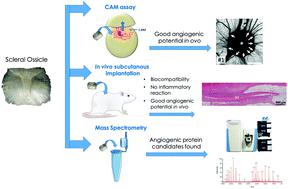当前位置:
X-MOL 学术
›
Biomater. Sci.
›
论文详情
Our official English website, www.x-mol.net, welcomes your
feedback! (Note: you will need to create a separate account there.)
Scleral ossicles: angiogenic scaffolds, a novel biomaterial for regenerative medicine applications.
Biomaterials Science ( IF 5.8 ) Pub Date : 2019-11-06 , DOI: 10.1039/c9bm01234f Marta Checchi 1 , Jessika Bertacchini , Francesco Cavani , Maria Sara Magarò , Luca Reggiani Bonetti , Geltrude Rita Pugliese , Roberto Tamma , Domenico Ribatti , Delphine B Maurel , Carla Palumbo
Biomaterials Science ( IF 5.8 ) Pub Date : 2019-11-06 , DOI: 10.1039/c9bm01234f Marta Checchi 1 , Jessika Bertacchini , Francesco Cavani , Maria Sara Magarò , Luca Reggiani Bonetti , Geltrude Rita Pugliese , Roberto Tamma , Domenico Ribatti , Delphine B Maurel , Carla Palumbo
Affiliation

|
Given the current prolonged life expectancy, various pathologies affect increasingly the aging subjects. Regarding the musculoskeletal apparatus, bone fragility induces more susceptibility to fractures, often not accompanied by good ability of self-repairing, in particular when critical-size defects (CSD) occur. Currently orthopedic surgery makes use of allografting and autografting which, however, have limitations due to the scarce amount of tissue that can be taken from the donor, the possibility of disease transmission and donor site morbidity. The need to develop new solutions has pushed the field of tissue engineering (TE) research to study new scaffolds to be functionalized in order to obtain constructs capable of promoting tissue regeneration and achieve stable bone recovery over time. This investigation focuses on the most important aspect related to bone tissue regeneration: the angiogenic properties of the scaffold to be used. As an innovative solution, scleral ossicles (SOs), previously characterized as natural, biocompatible and spontaneously decellularized scaffolds used for bone repair, were tested for angiogenic potential and biocompatibility. To reach this purpose, in ovo Chorioallantoic Membrane Assay (CAM) was firstly used to test the angiogenic potential; secondly, in vivo subcutaneous implantation of SOs (in a rat model) was performed in order to assess the biocompatibility and the inflammatory response. Finally, thanks to the analysis of mass spectrometry (LCMSQE), the putative proteins responsible for the SO angiogenic properties were identified. Thus, a novel natural biomaterial is proposed, which is (i) able to induce an angiogenic response in vivo by subcutaneous implantation in a non-immunodeficient animal model, (ii) which does not induce any inflammatory response, and (iii) is useful for regenerative medicine application for the healing of bone CSD.
中文翻译:

巩膜小骨:血管生成支架,一种用于再生医学应用的新型生物材料。
考虑到当前预期寿命的延长,各种病理因素对衰老对象的影响越来越大。关于肌肉骨骼设备,骨脆性引起更多的骨折敏感性,通常不伴有良好的自我修复能力,特别是在发生临界尺寸缺损(CSD)时。当前,整形外科手术利用同种异体移植和自体移植,但是由于可从供体获取的组织数量稀少,疾病传播的可能性和供体部位发病率的原因,其具有局限性。开发新解决方案的需求推动了组织工程(TE)研究领域的研究,以研究要进行功能化的新支架,以获得能够促进组织再生并随着时间的推移实现稳定的骨恢复的构建体。这项研究的重点是与骨组织再生有关的最重要方面:要使用的支架的血管生成特性。作为一种创新的解决方案,对巩膜小骨(SOs)进行了血管生成潜力和生物相容性测试,该巩膜小骨以前被表征为用于骨修复的天然,生物相容性和自发脱细胞的支架。为了达到这个目的,在卵内,首先采用绒膜尿囊膜测定法(CAM)检测血管生成的潜力。其次,进行了SOs的体内皮下植入(在大鼠模型中),以评估其生物相容性和炎症反应。最后,借助质谱分析(LCMSQE),鉴定了负责SO血管生成特性的推定蛋白质。因此,提出了一种新颖的天然生物材料,其(i)能够通过在非免疫缺陷动物模型中皮下植入而在体内诱导血管生成反应,(ii)不诱导任何炎症反应,并且(iii)是有用的。用于骨骼医学可持续发展的愈合的再生医学应用。
更新日期:2019-11-06
中文翻译:

巩膜小骨:血管生成支架,一种用于再生医学应用的新型生物材料。
考虑到当前预期寿命的延长,各种病理因素对衰老对象的影响越来越大。关于肌肉骨骼设备,骨脆性引起更多的骨折敏感性,通常不伴有良好的自我修复能力,特别是在发生临界尺寸缺损(CSD)时。当前,整形外科手术利用同种异体移植和自体移植,但是由于可从供体获取的组织数量稀少,疾病传播的可能性和供体部位发病率的原因,其具有局限性。开发新解决方案的需求推动了组织工程(TE)研究领域的研究,以研究要进行功能化的新支架,以获得能够促进组织再生并随着时间的推移实现稳定的骨恢复的构建体。这项研究的重点是与骨组织再生有关的最重要方面:要使用的支架的血管生成特性。作为一种创新的解决方案,对巩膜小骨(SOs)进行了血管生成潜力和生物相容性测试,该巩膜小骨以前被表征为用于骨修复的天然,生物相容性和自发脱细胞的支架。为了达到这个目的,在卵内,首先采用绒膜尿囊膜测定法(CAM)检测血管生成的潜力。其次,进行了SOs的体内皮下植入(在大鼠模型中),以评估其生物相容性和炎症反应。最后,借助质谱分析(LCMSQE),鉴定了负责SO血管生成特性的推定蛋白质。因此,提出了一种新颖的天然生物材料,其(i)能够通过在非免疫缺陷动物模型中皮下植入而在体内诱导血管生成反应,(ii)不诱导任何炎症反应,并且(iii)是有用的。用于骨骼医学可持续发展的愈合的再生医学应用。







































 京公网安备 11010802027423号
京公网安备 11010802027423号